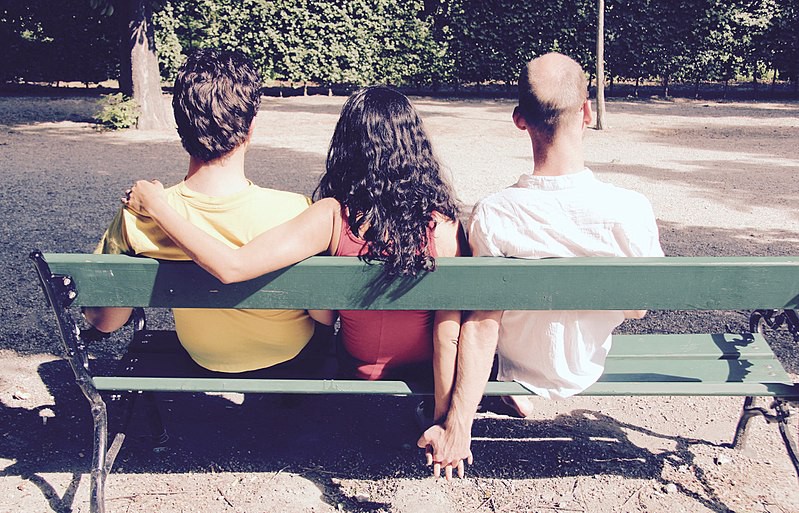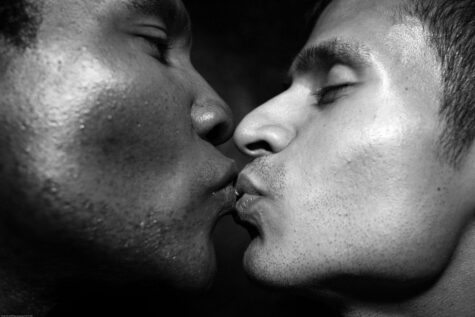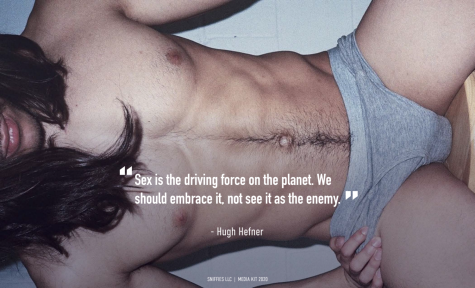10 Years Monogamish: The Ebb and Flow of Polyamory
My relationship didn’t need to follow the systemic ideology of monogamy
In the gay community, it’s common for couples to be non-monogamous in some way or another. Gays in open, polyamorous, polyfidelity, as well as other monogamish relationships, run rampant on dating apps. But most people don’t really understand the massive amount of self-awareness and trust needed in yourself and your relationship to be comfortable opening up intimately to more than one person. I know this because my boyfriend and I have spent a decade flirting, swapping pictures, dating and sleeping with other guys while in a happy and successful relationship with each other.
It started in 2013.
My boyfriend and I had been dating for over a year when my best friend, Vander, casually asked us, “Would you date another guy together?” While this question may not go over well with heterosexual couples, this seems to be a common “fair game” question for us gays. Despite my openness with everything else in my life, a twinge of panic shot down my spine as my boyfriend and I looked at each other, blushed, and sheepishly nodded in unison that we were open to the idea.
I can’t say this question came out of nowhere, however. Vander, my boyfriend, and I had just spent hours discussing the nuances of gay relationships versus straight relationships with all the gory details. The problem with this question in particular was my boyfriend and I never previously talked about opening our relationship.
It’s strange for me, now, to think about polyamory being this taboo or scandalous “thing,” but our relationship was young and we were nervous that talking about it would somehow put a death sentence on what was working really well. Once it was out in the open (thanks, Vander, you quirky bastard), we had to confront it. That night, we started a conversation that’s been ongoing for almost a decade.
While every polyamorous person approaches the subject differently, my ideals for polyamory were grounded in experience and practicality. I had known from a very early age that I was gay, and I had a knack for luring the “straight” guys around me into experimentation. But as someone who is driven more by the cold, hard logic of my mind — rather than my emotions — it was difficult for me to equate sexual experiences with intimacy. Like some knock-off Vulcan from Star Trek, I found the idea of multiple partners in my life with different roles… logical. The idea of a single person fulfilling every physical, emotional and psychological need feels like an unfair burden. I have plenty of friends to fulfill various emotional and psychological needs, so why shouldn’t I also have multiple sexual partners?
My boyfriend, on the other hand, is primarily driven by his heart; his approach to polyamory is the complete opposite. Like me, he struggled with the idea of fitting into the traditional heterosexual ideal of monogamy, but he had a complicated history with his sexuality as well as no faith in marriage, thanks to a lifetime of model relationships falling apart around him. Also, at the age of 22, with me as his first boyfriend, he felt he missed out on a lot of the pivotal “coming of age” experiences that help someone grow and learn how to be a mature partner. Beyond these personal hang-ups, he has a bottomless well of love to share with the people close to him, and part of that love is both a physical and sexual connection; with so much to give, the idea of restriction for him is akin to being a bird in a cage.
Despite our love and dedication to each other — resulting in a comfortable and happy monogamous partnership — polyamory was our safety net. By talking about our histories and expectations for what a long-term relationship between us would look like, we found that not only did we not want to break up, but we wanted an even deeper commitment with each other because we found compatibility on the level of soulmates.
Lucky for us, we weren’t pioneers or sexual deviants existing on the fringes of the queer community.
Gay men prior to the gay liberation movement were predominantly non-monogamous, refusing to conform to the heterosexual standards of romance and marriage they had been excluded from, due to systemic and societal oppression. While more and more of today’s young gay men are seeking monogamy — a likely result of the queer community becoming more accepted and integrated into society, thus adopting these societal standards as their own — there is still a significant portion of gay men exploring their sexual and romantic identity outside of the monogamous structure dominating the straight world.
But what does that polyamory look like for us? There are as many expressions of polyamory as there are people, so it took time to find our own rhythm. But every guy we meet is different, which means our polyamory is still evolving today.
Without a clear model for what a relationship with another guy would look like, we started with checking out guys on dating apps together, talking about them and what we would expect from them if a connection was possible. These conversations were awkward at first; when you’re raised on monogamy, sharing your thoughts on other guys to your boyfriend makes you wonder if he feels inadequate or self-conscious. Open and honest communication is key for these things, and we would change course if there were ever issues. There never was. This was what felt comfortable for us both, giving us an entry point into the “monogamish” while still being non-committal enough that feelings wouldn’t be hurt from diving headfirst into unfamiliar territory.
On our first few dates with other guys, we had a lot of hiccups with miscommunications.
Trying out a new relationship — even when you’re already in one — creates the same first date jitters all over again, no matter how many times you do it. It’s a learning process after all, and it requires constant reevaluation of your dynamics. Just like monogamous dating, you get acquainted with the person and figure out how you mesh. On the rare occasion that one of us felt a tinge of jealousy or discomfort, we would talk about it, just as you should in any monogamous relationship. We found out quickly that any problems in your monogamous relationship are amplified by a polyamorous one, so you’ve got to be upfront and honest with your feelings. But that also comes with being receptive and understanding of those feelings from your partner.
As an example, we casually dated a guy about four years ago. It was fun and all got along well; but after a couple months, I had started to feel jealous about how much time and energy my boyfriend was putting into the guy when I didn’t have that same intimacy with the new guy. This was a completely unusual experience for me, and I didn’t know how to handle it. I was scared to bring it up to my boyfriend because I didn’t want to sour anything they had together. I knew the jealousy was ridiculous, but that didn’t change how I felt.
After a week of stewing, I finally brought it up to him as delicately as I could, something I should’ve done from the start. He reassured me and acknowledged my feelings. It’s embarrassing, but my boyfriend now has confirmation that I’m human and capable of unsavory emotions — something he’ll hold over my head forever. While things didn’t end up working out with the new guy (unrelated to my jealousy, I promise; the spark between us all fizzled out), he and my boyfriend still keep in touch to this day. A friend gained, and a net positive overall, which is lucky considering how that situation could have gone.
Our polyamorous adventures have an ebb and flow to them. After dating six guys, having casual encounters with a few more and chatting with what feels like hundreds, we are still no closer to having a long-term relationship with anyone outside of the two of us. We’ve gone years without dating anyone — the longest since discovering we were looking for a polyamorous life.
There’s been chats on dating apps here and there, but we’re a decade older now, and a bit tired of the dating scene. With our years of experience, we’ve seen too many single guys on these apps with an air of desperation to them. We just don’t vibe with that. I would equate that to dating apps being vapid wastelands where everyone just wants a NSA (no strings attached) fling, but my boyfriend and I first met on OkCupid in 2011, so we know the potential is there.
In the lapse of a long-term polyamorous partner, we’ve gotten engaged in the traditionally monogamous way. Sometimes traditions are the best way to express a sentiment, and I can proudly say I’ve influenced his change of heart on the idea of marriage.
The wedding has been postponed a few times due to COVID-19 among other things; but with our relationship being as seasoned as it is and how long we’ve been engaged, we’ve considered ourselves a married couple for quite some time.
Marriage won’t change our polyamorous natures, though. Polyamory is a decision, of course, but it’s also a state of being; our current relationship is always open to the possibility of more, even if it’s just the two of us for the long haul. It’s definitely not a type of relationship that everyone is equipped for, nor should people think they need to try it out to be current or edgy. Some people are just meant to be monogamous, and that’s okay.
Polyamory has received a bad rap over the years. The growing awareness of non-monogamous relationship types has created a trend where people try something “monogamish” to spice up their already failing relationship. These experiments usually lead to hurt feelings and misunderstandings because they don’t communicate intentions or boundaries. This may not always be the case, but I’ve seen many people get hurt and hurt others because they didn’t give enough time and consideration to what they were getting into. Ultimately, this leads to misconceptions that polyamory doesn’t work because it didn’t work for them, or that it’s immoral because it promotes lying, cheating, or disingenuous behavior; this is a backwards sentiment that completely undermines the trust, love, and bond that poly relationships form.
It’s weird that this needs to be said, but the people you date in a polyamorous relationship are not expendable objects.
Love can grow and feelings can be hurt if you aren’t careful; my boyfriend and I learned that lesson the hard way. One guy got emotionally attached too quickly when we were trying to take things extremely slow, and we were less than gentle with breaking things off. It was messy — to say the least — and something we don’t want to repeat.
Regardless, my point is this; polyamory is there and available to people who are having a hard time fitting in with the heteronormative standard of monogamy. Gay men and women have been successfully navigating polyamorous relationships for centuries, hidden in the shadows of the monogamous world the straights have built.
If you feel like monogamy isn’t for you and you can handle the emotional maturity involved in managing intimacy with multiple partners, you might discover a love that fulfills you in ways that monogamy never could.












